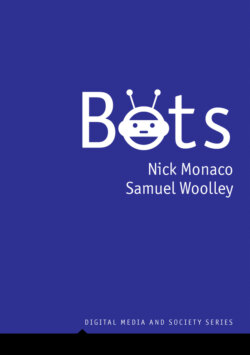Читать книгу Bots - Nick Monaco - Страница 10
Early bots – Daemons and ELIZA
ОглавлениеDaemons, or background processes that keep computers running and perform vital tasks, were one of the first forms of autonomous computer programs to emerge. In 1963, MIT Professor Fernando Corbato conceived of daemons as a way to save himself and his students time and effort using their shared computer, the IBM 7094. While it is debatable whether these programs count as bots (it depends on how you define bot), their autonomy makes them noteworthy as a precursor to more advanced bots (McKelvey, 2018).
A more recognizable bot emerged only three years later. In 1966, another MIT professor, Joseph Weizenbaum, programmed ELIZA – the world’s first (and most famous) chatbot,1 arguably “the most important chatbot dialog system in the history of the field” (Jurafsky & Martin, 2018, p. 425). ELIZA was a conversational computer program with several “scripts.” The most famous of these was the DOCTOR script, under which ELIZA imitated a therapist, conversing with users about their feelings and asking them to talk more about themselves. Using a combination of basic keyword detection, pattern matching,2 and canned responses, the chatbot would respond to users by asking for further information or by strategically changing the subject (Weizenbaum, 1966). The program was relatively simple – a mere 240 lines of code – but the response it elicited from users was profound. Many first-timers believed they were talking to a human on the other end of the terminal (Leonard, 1997, p. 52). Even after users were told that they were talking to a computer program, many simply refused to believe they weren’t talking to a human (Deryugina, 2010). At the first public demonstration of the early internet (the ARPANET) in 1971, people lined up at computer terminals for a chance to talk to ELIZA.
ELIZA captured people’s minds and imaginations. When Weizenbaum first tested out ELIZA on his secretary, she famously asked him to leave the room so they could have a more private conversation (Hall, 2019). Weizenbaum, who had originally designed the bot to show how superficial human–computer interactions were, was dismayed by the paradoxical effect.
I was startled to see how quickly and how very deeply people conversing with DOCTOR became emotionally involved with the computer and how unequivocally they anthropomorphized it, [Weizenbaum wrote years later]. What I had not realized is that extremely short exposures to a relatively simple computer program could induce powerful delusional thinking in quite normal people. (Weizenbaum, 1976, pp. 6–7)
This response was noteworthy enough to be dubbed the “ELIZA effect,” the tendency of humans to ascribe emotions or humanity to mechanical or electronic agents with which they interact (Hofstadter, 1995, p. 157).
